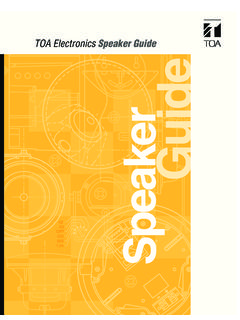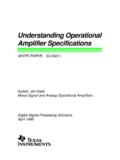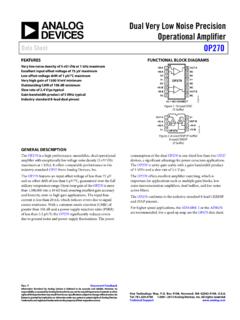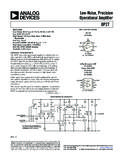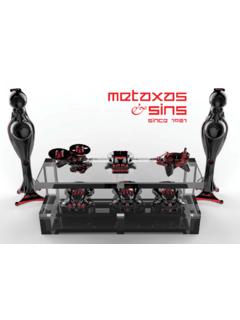Transcription of TOA Electronics Amplifier Guide Guide - TOA Canada
1 TOA Electronics Amplifier Guide4 8 8 VOLVOLREMTREMTOUTOUTIN/IN/BRGBRGOUTOUTAM PAMPPREPREININAMPAMPPWRPWROUTOUTAUXAUXMU TEMUTE1 MUTEMUTE2 GNDGND60W60W60Hz60Hz120V120 VCOMCOMDIRECTDIRECT25V25V70V70 VUNSWITCHED AC 120V 60 HzUNSWITCHED AC 120V 60 HzMAX 500W 4 AMAX 500W 4 AACACPROTECTPROTECTPOWERPOWERPEAKPEAKNOR MALNORMALSIGNALSIGNALMASTERMASTERONONOFF OFFTONE DEFEATTONE DEFEATTREBLETREBLEBASSBASSINPUT 8 INPUT 8 INPUT 7 INPUT 7 INPUT 6 INPUT 6 INPUT 5 INPUT 5 INPUT 4 INPUT 4 INPUT 3 INPUT 3 INPUT 2 INPUT 2 INPUT 1 INPUT 1 ONONOFFOFFLOW CUTLOW CUTOFFOFFONONPROGRAMPROGRAM100 MICMIC0 TELTEL100101010100 AUXAUX01010 MODULEMODULESIGNALSIGNALPOWERPOWERONONOF FOFFPEAKPEAKHOTHOTCOMCOM120V 60Hz120V 60Hz120V 50Hz120V 50 HzUNSWITCHEDUNSWITCHED150W150 WMAX 500 WMAX 500 WCLASS 2 WIRINGCLASS 2 WIRINGPROGRAMPROGRAMOUTPUT 120 WOUTPUT 120 WCOMCOM4 OUTLETOUTLET4A4 ABREAKERBREAKERGCOMCOM70V70V25V25V8 OUTPUT 1 WOUTPUT 1 WRESETRESETPUSHPUSHHOTHOTGTELTELCOMCOM10 10 NCNCRESETRESETMUTEMUTECOMCOMMOHMOH600600 GMICMICCOMCOMUNITUNITG4A4 ABREAKERBREAKERHOTHOTPUSHPUSHOUTPUT 1 WOUTPUT 1W0-+0
2 SENSESENSEBASSBASS01010 AUXAUXPREAMPPREAMP1010 MOHMOH0-+OUTOUTMUTEMUTETREBLETREBLEA0 BPOWERPOWERININMODULEMODULEPAGEPAGEBGMBG MCOMCOMHOTHOTINPUT LEVELINPUT LEVELLOW CUTLOW CUT-20dBV-20dBVOFFOFFONONINPUTINPUTDC FUSEDC FUSEDC FUSEDC FUSE250V 8A250V 8A250V 8A250V 8A250V 7A250V 7 AAC FUSEAC 1 WOUTPUT 1W-+0 BASSBASS01010 AUXAUXPREAMPPREAMPMOHMOH-+OUTOUTMUTEMUTE TREBLETREBLEA0 BPOWERPOWERININMODULEMODULEPAGEPAGEBGMBG M4 8 8 VOLVOLREMTREMTMUTEMUTE1 MUTEMUTE2 GNDGND60W60W60Hz60Hz120V120 VCOMCOMDIRECTDIRECT25V25V70V70 VUNSWITCHED AC 120V 60 HzUNSWITCHED AC 120V 60 HzMAX 500W 4 AMAX 500W 4 AACAC GuideTOA Electronics Amplifier GuideTable of 1: Selecting An 2: Amplifier 3: Amplifier /Speaker Impedance Impedance ( Volt) Distributed Line to Design a High Impedance Distributed 4: Level and Line Level Pair and Unshielded and Unbalanced Level Line Tap to Impedance Conversion Amplifier Amplifier Comparison A: Wire Size B.
3 Power Consumption & Thermal Electronics Amplifier GuideTOA Electronics Amplifier GuideWelcome to the TOA Amplifier Guide !TOA has been providing complete sound systems since 1934. After our first sales office was estab-lished in 1974, our TA-900 Series mixer/amplifiers quickly gained recognition for their unmatchedcombination of flexibility, reliability, and performance. Since that time, TOA has steadily expanded andimproved our line of amplifiers, mixer/amplifiers, and associated Electronics . The TOA 900 Series, nowin its 3rd generation of product design, is renowned for its flexible modular architechture, elegant sim-plicity of operation, and bulletproof reliability.
4 The new BG-M Series builds further on our tradition byoffering the flexibility of a module port in a package that is remarkably affordable without sacrificingeither performance or reliability. With six distinct series of amplifiers and mixer/amplifiers to choosefrom, plus a range of mixers, signal processors, and now network audio, TOA offers the most compre-hensive line of audio Electronics for systems TOA Amplifier Guide is a sound system design tool aimed at helping system designers, sales staff,installers and end users select the right amplifiers and accessories for their applications.
5 It includes areview of the basic concepts of audio amplification, such as signal flow, levels, and impedance, plususeful references such as thermal dissipation, power consumption and line loss charts, as well as tipsfor troubleshooting (including impedance measurement). Further information on speaker systemdesign and speaker selection and placement may be found in the TOA Speaker Guide , available fordownload at :This design Guide does not cover all of the general concepts underlying sound system designand installation, which would require several hundred pages.
6 This Guide is not meant to replace the par-ticipation of an experienced consultant or :For more in-depth coverage of sound system design principles, we recommend the fol-lowing two excellent books:Sound System Engineering, Second Edition, Don & Carolyn Davis, 1975, 1987 by Howard Sams & : 0-672-21857-7 Handbook for Sound Engineers: Third Edition, Glen Ballou, Editor, 2001, Butterworth & Heinemann. ISBN:0-240-80454-6 AcknowledgementsThanks to Steve Mate, Lucas Marciniak, and Martin Gonzalez in the TOA Product Support Group fortheir invaluable support and contributions to this project, and to Geraldine Vargas for designing thelayout.
7 This Guide is dedicated to the memory of my late father, whose amp-building projects on thekitchen table gave me a love for the smell of solder, and whose demonstrations of loudspeaker sensi-tivity gave me a love for the art of sound system MenascoProduct Application SpecialistTOA Electronics , Electronics Amplifier GuideChapter 1: Selecting An AmplifierAmplifiers are the heart of any sound system. In addition to providing the audio power for a system,amplifiers may also incorporate the input mixing and control functions vital to a system s operation(such an amp is called a mixer/ Amplifier ).
8 Selecting the right Amplifier or mixer/ Amplifier for a jobmeans choosing a set of features and characteristics suited to meet the customer s needs. The maincharacteristics of an Amplifier or mixer/ Amplifier include: The number and type of input channels, thenumber of busses (signal paths) and output channels, and the amount of output power per , weight and other basic parameters may also be important, depending on the needed for a job may include: Auto-muting ( voice-over-music), remote volume control,transformer-isolated inputs/outputs, phantom power, bass/treble controls, multi-level muting, rackmounting, equalization, or any of a number of other special purpose selecting an Amplifier , there are three key questions to consider:1.
9 What sound sources will be used?2. What speakers will it be driving?3. How does the client or end user need the system to operate?Answers to these questions will dictate what characteristics and features are needed. Below is a moredetailed look at each SourcesOne of the first questions you will need to answer, at least in general, is what sound sources will beused in the system. Will the system be used with microphones? A CD player? A telephone exchange?Due to standardization, many sources can be treated similarly for example, CD and DVD players,VCRs and computer sound cards all provide unbalanced line level outputs, usually with a similar out-put level, and thus may be treated the same in the design phase.
10 But it is still important to know howmany such sources you will have, and what other sources may also be RequirementsTwo more key questions when selecting an Amplifier is how much power is needed, and what kind ofload (impedance) the speakers will present and here, the answers will depend on the type of speak-ers used. It is usually preferable to select the speakers, or at least the general type of speakers, beforeselecting the Amplifier . Please refer to the TOA Speaker Guidefor information on selection and place-ment of speakers. Once the type of speakers has been determined, it will be possible to choose anamplifier with adequate power and an appropriate output Chapter 3 Amplifier /Speaker Matching for discussions of impedance, power levels, and line FunctionThe paramount rule of sound system design is almost too obvious, and yet it is all too often over-looked: it is important to let the system design be guided by the needs of the client or end user, andthe function they need the system to fill.

